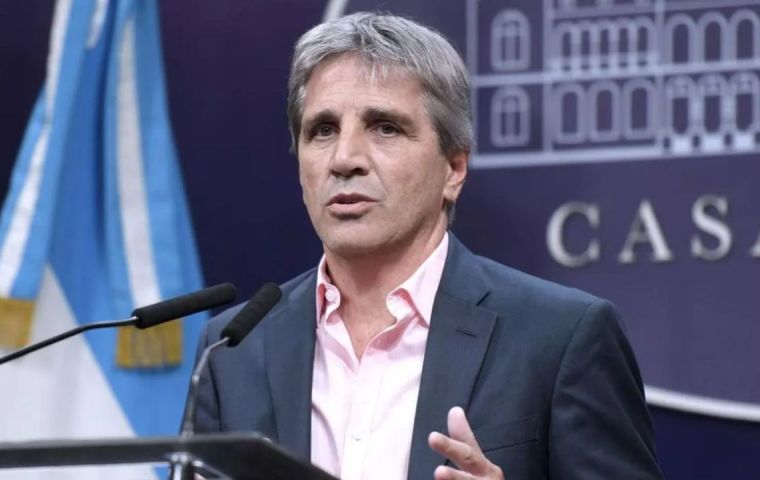MercoPress. South Atlantic News Agency
Argentina announces end of currency controls and introduces exchange rate band
 Economy Minister Luis Caputo said in a press conference at the Casa Rosada that the official exchange rate will now float between 1,000 and 1,400 pesos per US dollar
Economy Minister Luis Caputo said in a press conference at the Casa Rosada that the official exchange rate will now float between 1,000 and 1,400 pesos per US dollar The Argentine government announced today a sweeping overhaul of its foreign exchange regime, set to take effect on Monday, including the end of currency controls and the introduction of a managed float within a fixed exchange rate band. The move marks the beginning of what authorities are calling “Phase 3” of their economic program.
Economy Minister Luis Caputo said in a press conference at the Casa Rosada that the official exchange rate will now float between 1,000 and 1,400 pesos per US dollar, with monthly adjustments of 1% to both the floor and ceiling. The Central Bank (BCRA) will intervene only if the rate hits either extreme of the band.
“This marks the start of the Central Bank’s recapitalization phase,” Caputo said. “It allows us to support the pesos in circulation and move towards full monetary stability.”
The reforms follow a new $20 billion agreement with the International Monetary Fund, of which $15 billion will be freely available to the government in 2025, Caputo confirmed.
End of capital controls
For the first time in six years, individuals will be allowed to purchase US dollars freely at the official rate, as the government abolishes the long-standing “cepo cambiario” that had capped monthly purchases at $200. The Central Bank also removed tax penalties and restrictions linked to previous pandemic-era subsidies and public employment.
”The restrictions outlined in Communication A 7340 and the so-called ‘cross restrictions’ will no longer apply to individuals,” the Central Bank said in a statement.
Elimination of the “dólar blend”
The government will also scrap the “dólar blend” system, which had allowed exporters to sell 20% of their foreign currency earnings on the parallel market at a more favorable rate. All export revenue will now be settled through the official market, though timelines for currency liquidation remain unchanged.
Officials said the move would simplify Argentina’s currency framework and enhance liquidity in both spot and futures markets for foreign exchange and commodities.
Market Reactions and Outlook
While the official dollar rate closed at 1,078 pesos on Friday, the BCRA will now act as a buyer if the rate falls to 1,000 or below and as a seller if it hits or exceeds 1,400. These interventions aim to accumulate reserves or absorb excess liquidity, depending on demand for pesos.
The government hopes the changes will restore confidence in Argentina’s monetary system and pave the way for macroeconomic stability. Analysts, however, remain cautious about the country’s ability to sustain the new framework amid political and inflationary pressures.
Argentina’s currency reforms come amid broader efforts to stabilize the economy following years of crisis, chronic inflation, and capital flight.




Top Comments
Disclaimer & comment rulesCommenting for this story is now closed.
If you have a Facebook account, become a fan and comment on our Facebook Page!